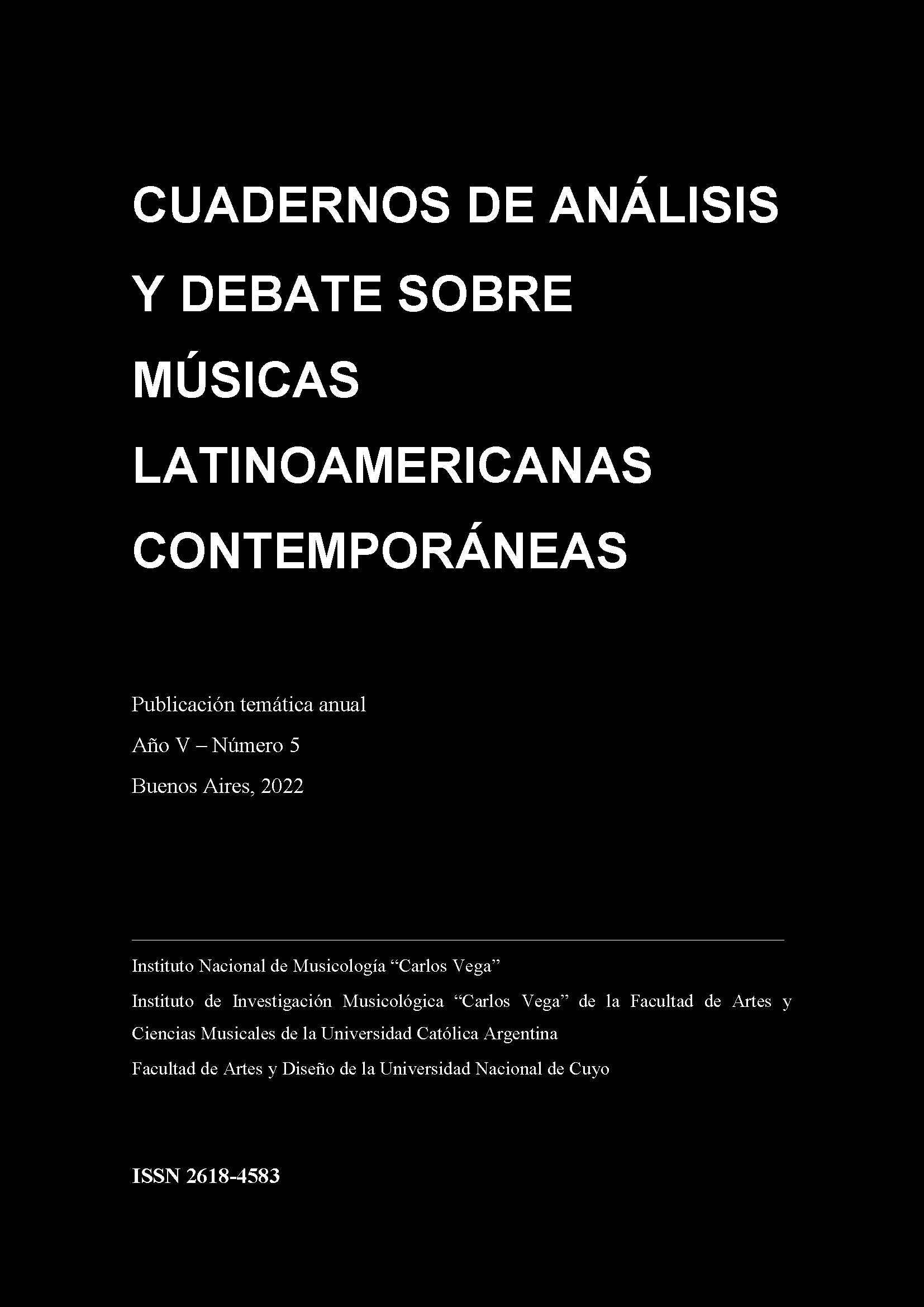Análisis comparativo de multifónicos en la familia de saxofones
Keywords:
multiphonics, saxophone, spectral analysis, timbreAbstract
This work presents a comparative analysis of multiphonics in the different members of the saxophone family. Starting from the intuitive premise that the same fingering on two different saxophones would result in the same multiphonic but transposed, 18 examples were analysed from two different perspectives: 1) multiphonics with the same fingering on different saxophones; 2) multiphonics with the same notes (sounding pitches) but different fingerings on different saxophones. In both cases, the study involved spectral analysis of a set of multiphonics specially selected for their particular characteristics, including a transcription to musical notation of the main spectral components. As a complement, the spectral analysis of similar multiphonics were compared, focusing on saxophones that share the same tuning (soprano and tenor saxophones in Bb, alto and baritone in Eb). The results obtained in this work, allow us to open research questions for the future, mainly considering timbre perception of those multiphonics that, sharing the same spectral structure, present amplitude variations in the pitch components between saxophones.
Downloads
References
Backus, J. (1978). Multiphonic tones in the woodwind instruments. The Journal of the Acoustical Society of America, 63(2), 591–599.
Chen, J. M., Smith, J., & Wolfe, J. (2011). Saxophonists tune vocal tract resonances in advanced performance techniques. The Journal of the Acoustical Society of America, 129(1), 415-426
Chen, J. M., Smith, J., & Wolfe, J. (2009). Saxophone acoustics: introducing a compendium of impedance and sound spectra. Acoustics Australia, 37(1-19), 18-23.
Gottfried, Rama. (2007) “A More Accurate Notation for Multiphonics Using Sideband Ratios”, en: www.ramagottfried.com/texts/rama_gottfried_multiphonics.pdf
Jaureguiberry, L. F. (2011). Análisis de sonidos multifónicos de base Bb3. Clang.
Kientzy, D. (1982). Les sons multiples aux saxophones. Editions Salabert
Londeix, J. M. (1989). Hello! Mr. Sax, ou Parametres du saxophone. Alphonse Leduc.
Riera, P. E., Proscia, M., & Eguia, M. C. (2014). A Comparative Study of Saxophone Multiphonics: Musical, Psychophysical and Spectral Analysis. Journal of New Music Research, 43(2), 202-213
Proscia, M., Riera, P. E., & Eguia, M. C. (2018) “Study of timbral modulation processes applied to saxophone multiphonic tones”. 15th International Conference on Music Perception and Cognition -10th triennial conference of the European Society for the Cognitive Sciences of Music, 23-28 July 2018.
Proscia, M. M. (2022). El saxofón multifónico: un modelo para pensar la modulación tímbrica. (Tesis de doctorado). Universidad Nacional de Quilmes, Bernal, Argentina. Disponible en RIDAA-UNQ Repositorio Institucional Digital de Acceso Abierto de la Universidad Nacional de Quilmes http://ridaa.unq.edu.ar/handle/20.500.11807/3832
Scavone, G. P., Lefebvre, A., & da Silva, A. R. (2008). Measurement of vocal-tract influence during saxophone performance. The Journal of the Acoustical Society of America, 123(4), 2391-2400.
Spinelli, E. (2010). Multifónicos en el clarinete: un estudio comparativo. Revista del Instituto de Investigación Musicológica Carlos Vega: Publicación de la facultad de Artes y Ciencias Musicales de la Universidad Católica Argentina, (24), 169-202.
Veale, Peter. y Claus-steffen Mahnkopf. (1994). The Techniques of oboe playing. Kassel: Bärenreiter
Weiss, M., & Netti, G. (2010). The techniques of saxophone playing (Vol. 37). Bärenreiter.
Wolfe, J., & Smith, J. (2003). Cutoff frequencies and cross fingerings in baroque, classical, and modern flutes. The Journal of the Acoustical Society of America, 114(4), 2263-2272.
Downloads
Published
How to Cite
Issue
Section
License
Copyright (c) 2022 Martín Proscia; Antonio Ortega Brook

This work is licensed under a Creative Commons Attribution-NonCommercial-ShareAlike 4.0 International License.







